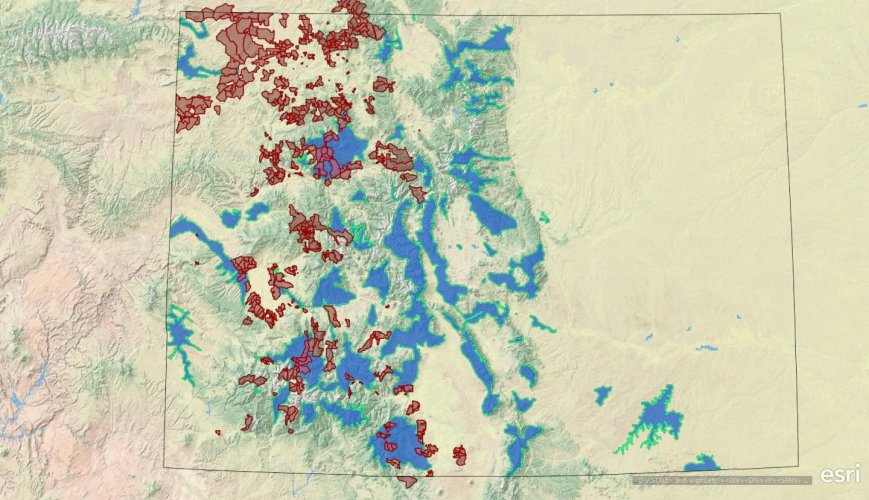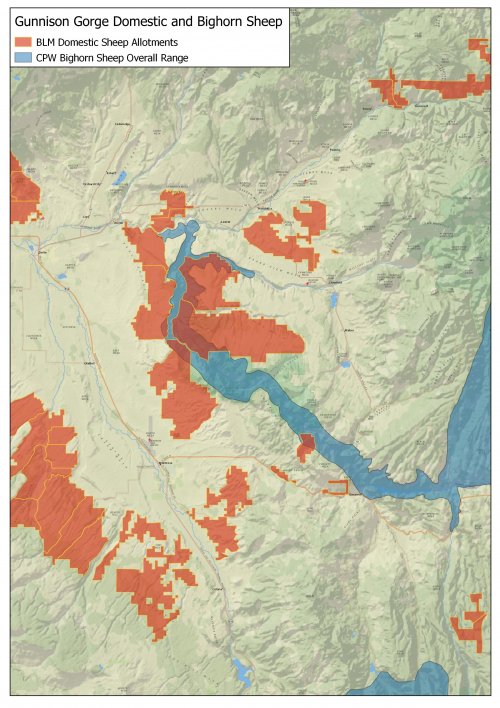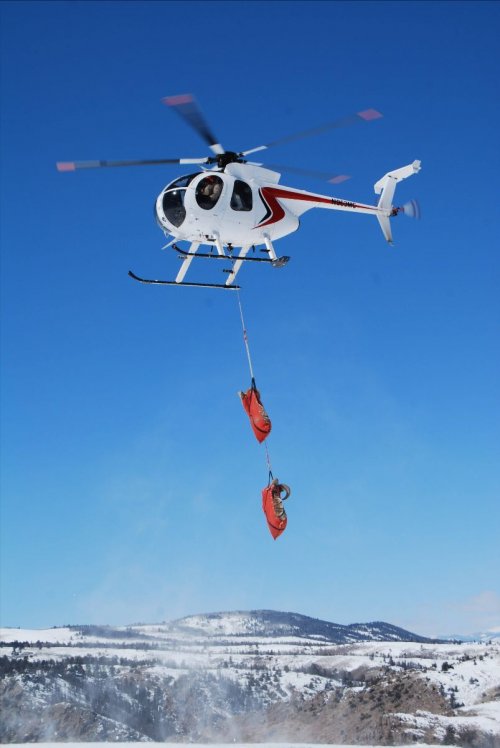I'm curious Oak, how does the RMBS determine which sheep herd to put the money towards? Obviously there are several herds across the state could use a few transplants. Why Beaver creek? Just curious how this process works.This is where it goes, folks. Yesterday CPW transplanted 21 bighorn sheep from the Rampart herd to Beaver Creek, south of Skaguay Reservoir. These sheep will augment the remnant population that persisted following a die-off decades ago. This project was 100% funded by auction and raffle revenue generated by RMBS, except for CPW staff time.
Navigation
Install the app
How to install the app on iOS
Follow along with the video below to see how to install our site as a web app on your home screen.
Note: This feature may not be available in some browsers.
More options
You are using an out of date browser. It may not display this or other websites correctly.
You should upgrade or use an alternative browser.
You should upgrade or use an alternative browser.
CO bighorn sheep, mountain goat, and pronghorn raffles
- Thread starter Oak
- Start date
In case you are wondering about the sheep and goat units and season dates the 2022 regs are online.
There are two funding mechanisms for using auction and raffle revenue. The 75% of revenue that is returned by the NGOs to CPW is held in dedicated accounts for each species. A project advisory committee comprised of CPW, USFS, BLM, and representatives from the NGOs that have been awarded auction and raffle licenses meets once a year in May to evaluate and approve or deny project proposals that have been submitted prior to the annual April 30 deadline.I'm curious Oak, how does the RMBS determine which sheep herd to put the money towards? Obviously there are several herds across the state could use a few transplants. Why Beaver creek? Just curious how this process works.
The RMBS has their own grant-in-aid application process that is open year-around, in which projects are generally approved or denied in a 1-3 month timeframe.
To your question about transplants, CPW policies dictate they may consider transplants and herd augmentations. The primary factors considered are:
Tier status of the existing herd - Tier 1 herds are generally not going to be considered for augmentation. CPW defines Tier 1 herds as:
Primary (Tier 1) core Rocky Mountain bighorn
populations (to be designated as DAUs) are regarded
as those large (i.e., ≥100 animals for ≥90% of the years
since 1986), native populations comprised of one or
more interconnected herds (in, or to be designated into,
GMUs) that have received few (i.e., ≤50 animals total)
if any supplemental releases of Rocky Mountain bighorn
sheep in the past. In some cases, smaller (<100 animals)
indigenous populations may be justifiably regarded as
core populations when restoration to a larger size is
deemed feasible. Performance potential in respect to
factors such as habitat condition and trend, and proximity
to and intensity of domestic sheep and domestic goats
also should be considered. These populations likely
represent those indigenous Rocky Mountain bighorn
sheep populations that have maintained the greatest
genetic diversity and their ranges represent habitats where
bighorn populations have best been able to persist in
sizable numbers despite various adversities.
Proximity to public land domestic sheep grazing allotments - CPW spent decades augmenting and attempting to restore bighorn populations in close proximity to domestic sheep grazing allotments. The outcome was often small, stagnant herds of bighorn sheep constantly challenged by disease*, and/or a new conflict for federal land managers to deal with when considering grazing decisions. Transplant herds in close proximity to domestic sheep are a lower priority for limited management resources.
Here's what the domestic sheep allotment (red) situation looks like in relation to existing bighorn sheep herds.

*A good example from the past of attempting to reestablish bighorn sheep in an area where they would immediately be challenged by disease is Gunnison Gorge. This herd was established through 4 translocations: 1986 (20), 1987 (23), 1988 (19), and 1990 (20) into the lower Gunnison Gorge. The herd grew to an estimated 125 animals before crashing around 1995. It has remained stagnant at around 25-35 animals since then. Here's what the domestic sheep allotment situation looks like around the Gunnison Gorge.

DJ1
Active member
- Joined
- Jul 5, 2020
- Messages
- 109
I almost bought some more with that sales pitch. LolSuper Bowl special this afternoon. These are all 4/$100. Moose tickets are 2/$400. Don’t miss out.
Bluffgruff
Well-known member
Finally put my first order through. One of several, I'm sure.
mountainlaurel3
Well-known member
There are two funding mechanisms for using auction and raffle revenue. The 75% of revenue that is returned by the NGOs to CPW is held in dedicated accounts for each species. A project advisory committee comprised of CPW, USFS, BLM, and representatives from the NGOs that have been awarded auction and raffle licenses meets once a year in May to evaluate and approve or deny project proposals that have been submitted prior to the annual April 30 deadline.
The RMBS has their own grant-in-aid application process that is open year-around, in which projects are generally approved or denied in a 1-3 month timeframe.
To your question about transplants, CPW policies dictate they may consider transplants and herd augmentations. The primary factors considered are:
Tier status of the existing herd - Tier 1 herds are generally not going to be considered for augmentation. CPW defines Tier 1 herds as:
Proximity to public land domestic sheep grazing allotments - CPW spent decades augmenting and attempting to restore bighorn populations in close proximity to domestic sheep grazing allotments. The outcome was often small, stagnant herds of bighorn sheep constantly challenged by disease*, and/or a new conflict for federal land managers to deal with when considering grazing decisions. Transplant herds in close proximity to domestic sheep are a lower priority for limited management resources.
Here's what the domestic sheep allotment (red) situation looks like in relation to existing bighorn sheep herds.
View attachment 212014
*A good example from the past of attempting to reestablish bighorn sheep in an area where they would immediately be challenged by disease is Gunnison Gorge. This herd was established through 4 translocations: 1986 (20), 1987 (23), 1988 (19), and 1990 (20) into the lower Gunnison Gorge. The herd grew to an estimated 125 animals before crashing around 1995. It has remained stagnant at around 25-35 animals since then. Here's what the domestic sheep allotment situation looks like around the Gunnison Gorge.
View attachment 212030
So when I saw 7 or 8 ewes/lambs on the river that was like a quarter of the whole population? Wow.
I think there are a few more sheep in there now, to be honest. In fact, I wouldn't be surprised if they open the unit to a ram tag sometime in the next couple of years. There are no real organized survey efforts in that unit right now, so information is anecdotal. Certainly more people have been reporting sheep in the last couple of years.So when I saw 7 or 8 ewes/lambs on the river that was like a quarter of the whole population? Wow.
mountainlaurel3
Well-known member
Damn, that would be a sweet tag, and probably dangerous.I think there are a few more sheep in there now, to be honest. In fact, I wouldn't be surprised if they open the unit to a ram tag sometime in the next couple of years. There are no real organized survey efforts in that unit right now, so information is anecdotal. Certainly more people have been reporting sheep in the last couple of years.
davinski
Well-known member
Hey, I recognize that raffle winner. I hear he's pretty stoked!!
Awesome man.Hey, I recognize that raffle winner. I hear he's pretty stoked!!
The second Swarovski raffle has started, and there are quite a few Yukon hunt raffle tickets left. That one is drawn next week.
Thanks Oak. I’m for another round.
davinski
Well-known member
Last raffle I ever won was a paintball gun in 1990. The hunt sounds absolutely fantastic, can't wait!Awesome man.
Addicting
Well-known member
Congrats Dave!!!
Don't make me pull up a picture. ahahhahahahahLast raffle I ever won was a paintball gun in 1990.
Looking forward to hearing about the adventure.
marksjeep
Well-known member
Dang. Two awesome tag threads today. Congrats Dave!
Similar threads
- Replies
- 38
- Views
- 2K
- Replies
- 193
- Views
- 15K
- Replies
- 1
- Views
- 874
- Replies
- 29
- Views
- 1K





